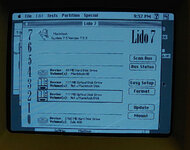rjkucia
Well-known member
To answer some of your questions:
- The Mac Plus has a weird/non-standard SCSI implementation that doesn't provide enough power for devices, so I believe you do need external power for all SCSI devices
- The Mac Plus will work great with System 6. Depending on how much RAM it has, System 7 might work okay, but generally 6 will be a more pleasant experience.
- Here are some good pre-made images: https://macintoshgarden.org/apps/rascsi-reloaded The RaSCSI, ZuluSCSI, and BlueSCSI all use the same types of images, so they're interchangeable.
- The Mac Plus does not have internal SCSI, as far as I know, so you'll need to use the external DB25. It looks like ZuluSCSI has an empty header for that, so you'll have to add it (or purchase one that has it pre-installed). You can attach two DB25 SCSI devices with a cable or a gender changer, such as this one: https://samplerzone.com/products/scsi-db25-db25-gender-changer I'm not sure how well that will mechanically fit in your setup, though.

